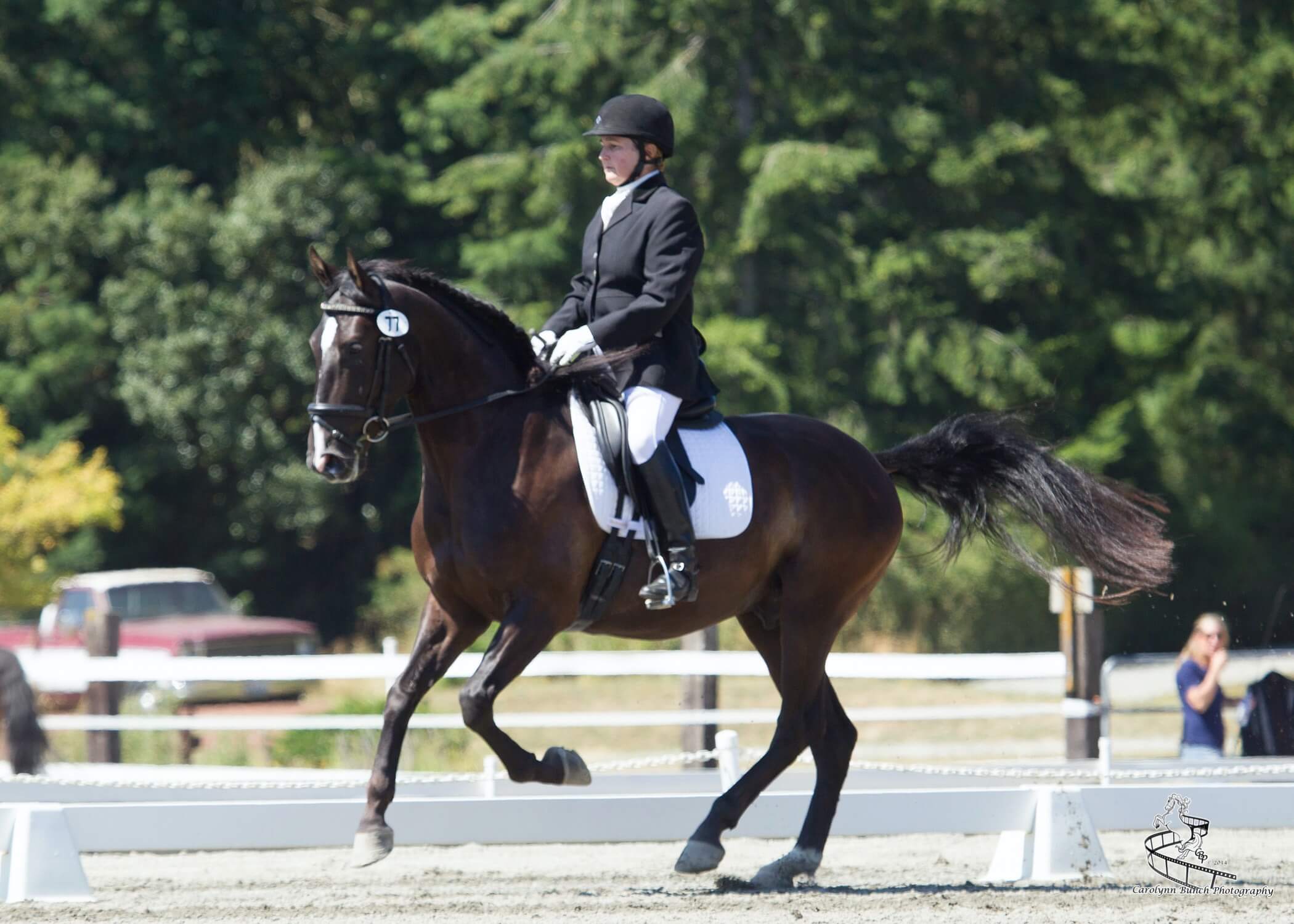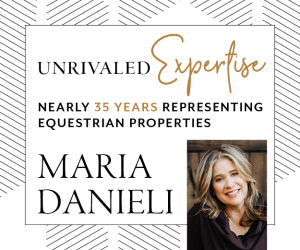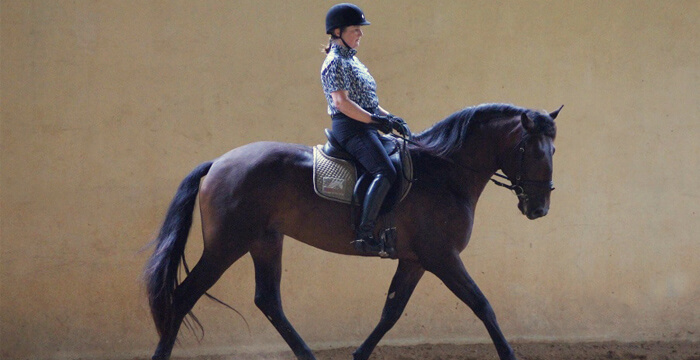The ability to ride your horse forward is an important basic no matter your discipline. Even if your goal is to have a slow-moving pleasure horse, it’s still important to train your horse to go forward. Horses need to move actively forward for their physical and mental health, and for your control and safety. Steering and stopping will be difficult without forward, lateral movements won’t be possible, and you won’t be able to progress to collection or extension if the horse doesn’t clearly understand and respond to the driving aids.
Defining Forward
So, what does your trainer/instructor want when they tell you to ride forward? The word is problematic in that it encompasses many ideas in riding. Forward is NOT fast. When your horse is going forward it’s similar to you walking up hill with long strides or going up a flight of stairs. If you take the stairs two at a time, you’re reaching “through” your body and really working. Often, we move our legs slowly while doing this, not quickly, and our strides are regular and rhythmic.
A horse moving fast, or quick, is not necessarily forward. When I was a child, I used to love to run downhill until I couldn’t stop. I felt like I had to pick my feet up quickly or I’d fall down. I arched my back and stiffened my neck to keep from tumbling head over heels. It was a rush, but very little “work” was involved. I was just using momentum and gravity to run.
This is the same as a “running” horse, and it results tight backs and braced necks which leads to problems in both training and soundness. Horses who’ve been raced on the track or in gaming events are often using themselves this way. They understand “go” (and this is a good thing) but they are so balanced on the forehand they’re not correctly pushing from behind and often have very tight backs. Also, horses that are overbuilt behind (downhill conformation) can suffer from this problem. We actually have to slow these horses’ tempos (the speed of the rhythm) in order to find their forward gears.
It’s important to realize tempo and forward are intricately connected to each other. I can’t tell you without seeing you and your horse work what’s the correct tempo for your horse. Each horse is different. The goal is free forward movement that results in long, slow, steady (rhythmic), pushing strides and a relaxed topline. Riders can experiment with tempo changes until they find the one that results in this “sweet spot” with their horse. Riders will feel as though they can quit working and the horse lifts them on a swinging back. They’ll feel they don’t have to push the horse and that he coasts along easily. If the rider relaxes, the horse keeps going. It should always be easy to ride a downward transition from here, without pulling on the reins. If it’s hard to stop, the horse isn’t forward, he’s running.
The Elements of Forward
Because the term “forward” is vague, we need to be clearer when using the term. What exactly do we want from the horse? Below are the qualities of forwardness:
- Direction of movement – Can you ride a round circle and a straight line? Do you meet your jumps or obstacles straight and in the middle? Does your horse stay on the wall of an arena or in the middle of the trail? If your horse wobbles and meanders he’s not going forward.
- Energy – Bring the zing! Riders need to bring their own energy and enthusiasm to the riding in order for their horses to feel it. Forward horses aren’t sluggish—they’re responsive.
- Stride length – Does the horse “track-up”? Does he overstep his front footprints with his hind feet?
- Reach – Does the horse reach through his shoulders and hind legs? Does his back, loin, and croup flex when he moves? Does he bend the joints of his legs? Does his neck undulate in the walk and canter?
- Desire to move – Is he crabby about moving off the leg? Does he pin his ears, kick at the rider’s leg and move sideways instead of straight? If the rider stops kicking or squeezing, does the horse slow down or break gait? (If you answered yes to these questions your horse is NOT forward.)
Impulsion vs. Forward
I often hear these terms interchanged, and though they are related, they’re not the same. Impulsion adds an element of thrust that results in air-time in the horse’s gait. It’s what creates that beautiful moment of suspension in trot and canter. (There’s no impulsion in walk, as the nature of the gait doesn’t allow suspension, but a walk must be actively forward and energetic.)
A horse will not find impulsion without going forward, but a horse can be forward but not yet able to have impulsion. Forward activity is a prerequisite of impulsion. Impulsion is created when the rider contains the forward energy through half-halts and straightening aids. Impulsion results in a great jump, a beautiful passage or floating trot extensions. The difference between impulsion and forward is the difference between humans dancing and jogging. Dancing has impulsion.
Why We Must Ride Forward:
- Safety—The first requirement in training is that the horse steps forward willingly to the rider’s legs. Forward movement allows steering and stopping. As the saying goes, “You can’t shut a door you haven’t opened” and you can’t stop a horse that won’t go. Horses who won’t go are braced and tense in their bodies and minds.
- Stopping— As mentioned above, going forward means you get to practice stopping. Horses who bolt aren’t going forward—they’re running. Often these horses are behind the leg and sluggish to it. Sometimes they don’t understand the driving aids and are afraid of the legs. Lazy and spooky are the different sides of the same coin.
- Straightness – When you ride a bicycle you know that once you lose momentum you’ll begin to wobble and unless you start to pedal, you’ll eventually tip over. Forward energy keeps the bicycle on the path. The same is true for horses. You can’t keep your horse straight in his body or straight on a path if he’s not going forward.
- Collection—Forward activity also creates the opportunity to contain or send the energy and create collection or extension (impulsion.) Watch a grand prix jumping rider prepare her horse for a giant jump. She takes all that energy (forward desire) and collects it back on the horse’s hocks, and then releases the energy over the fence like a slingshot. Collection is the bending of the horse’s joints and the lowering of the haunches. It’s not about the neck.
- Improved connection—Do you want your horse softer in your hand, longer in the neck, and quietly accepting the bit? Ask yourself if your horse is going forward to the contact, from the back end to the front end. No pulling!
- Suppleness –Especially in the horse’s back and hindquarters. Pull your knees to your chest. This is how bringing the hindlegs actively under the horse creates a more supple topline. Climb up stairs or a steep hill – you’ll feel warmth in your thighs, hips, legs, and buttocks. Same for horses. Suppleness equals strength and flexibility. They need to use their bodies to have it.
Riding your horse actively forward is one of the first requirements of training. Some horses give us this easily, others need to constantly be reminded to stay active and in front of the leg. Sometimes there’s a health issue involved. Horses in pain will not want to go forward, so if this is a problem in your training that isn’t being resolved, check in with your veterinarian.
Sometimes we need to find activities for our horses like cavalleti work, trail riding, or obstacle work to increase our horses desire to go forward and “bring the zing”. As horses become more trained, we need to continually ask ourselves if they are willingly moving forward or if the work has become dull and boring to the horse. Arena sour, unhappy horses will resist the work and forward energy will be hard to achieve. Give your horse a job he likes and he will be more willing to go forward.
View the full May 2020 edition here.

Kim Roe grew up riding on the family ranch and competed in Western rail classes, trail horse, reining, working cow, and hunter/jumper. She trained her first horse for money at 12 years old, starting a pony for a neighbor.
Kim has been a professional dressage instructor in Washington state for over 30 years, training hundreds of horses and students through the levels. In recent years Kim has become involved in Working Equitation and is a small ‘r’ Working Equitation judge with WE United.
Kim is the editor of the Northwest Horse Source Magazine, and also a writer, photographer, and poet. She owns and manages Blue Gate Farm in Deming, Washington where she continues to be passionate about helping horses and riders in many disciplines.






